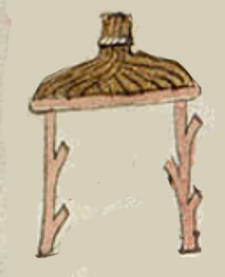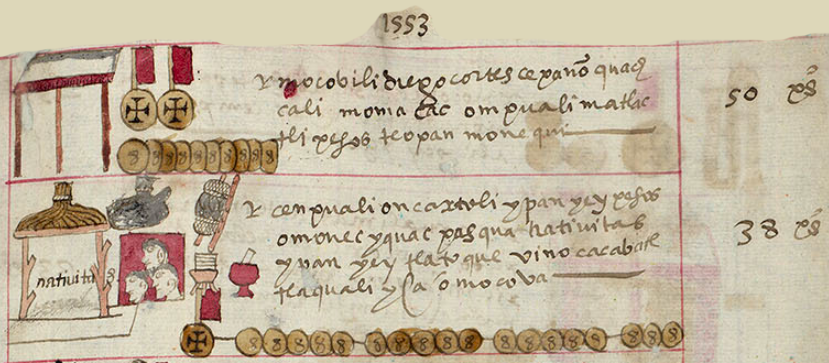nativitas (CST9)
This painting of the simplex glyph for the term nativitas (a loan from Spanish that was taken into Nahuatl) shows a structure that apparently served for the creation of a nativity scene. The glyph shows two, pink, upright tree trunks with the branches chopped off (leaving stumps). These uprights support a horizontal beam. A thatched roof rises from this horizontal beam, whereby the thatch is gathered in a point at the top and tied with a white rope or cord.
Stephanie Wood
The thatching on this roof is somewhat akin to that on some of the cuezcomatl structures (see below), which can also come to a point at the top. Nativitas also became a popular place name in colonial Mexico (New Spain). For more on the Codex Sierra, see Kevin Terraciano’s study (2021).
Stephanie Wood
1550–1564
Jeff Haskett-Wood
vigas, pabellón, toldo, iglesia, religión, canopy, paja, cuezcomates, soga, mecate, mecates, cuerda, cuerdas, sogas, cordones, cordel, cordeles

nativitas, nativity (a term taken into Nahuatl from Spanish), https://nahuatl.wired-humanities.org/content/nativitas
nativitas
Stephanie Wood
Códice Sierra-Texupan, plate 9, page dated 1553. Origin: Santa Catalina Texupan, Mixteca Alta, State of Oaxaca. Kevin Terraciano has published an outstanding study of this manuscript (Codex Sierra, 2021), and in his book he refers to alphabetic and “pictorial” writing, not hieroglyphic writing. We are still counting some of the imagery from this source as hieroglyphic writing, but we are also including examples of “iconography” where the images verge on European style illustrations or scenes showing activities. We have this iconography category so that such images can be fruitfully compared with hieroglyphs. Hieroglyphic writing was evolving as a result of the influence of European illustrations, and even alphabetic writing impacted it.
https://bidilaf.buap.mx/objeto.xql?id=48281&busqueda=Texupan&action=sear...
The Biblioteca Digital Lafragua of the Biblioteca Histórica José María Lafragua in Puebla, Mexico, publishes this Códice Sierra-Texupan, 1550–1564 (62pp., 30.7 x 21.8 cm.), referring to it as being in the “Public Domain.” This image is published here under a Creative Commons license, asking that you cite the Biblioteca Digital Lafragua and this Visual Lexicon of Aztec Hieroglyphs.





